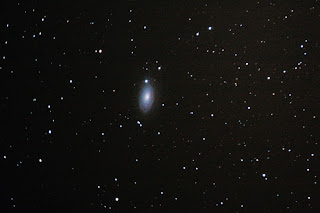Several differences from the original attempt: first it was with a longer focal length scope and so a larger image. Secondly, there were a few more exposures, although still not nearly enough to make me happy. Only about 15 passed muster upon inspection, and I'd like at least four times that many.
However, the detail is definitely better. One thing that really rankles though - eggy stars again! Really need to get on with this autoguiding malarkey (where a smaller scope guides the main imaging scope in order to allow longer exposures and prevent star trailing - eggs to you and me!) as I'm getting bored of saying the images are 'OK' or 'alright'. Would really like to get it down so that I can start posting something really good!
Anyway - M13 - strike two:
.jpg) |
| M13: The Great Globular Cluster in Hercules |
M13: The Great Globular Cluster in Hercules
Comprised of around 300,000 stars, M13 (a.k.a. NGC 6205) lies over 20,000 light years away and orbits the Milky Way as a tiny companion; a collection of stars too small to be a galaxy, but yet still very large and extremely old. Many such clusters orbit our galaxy and as such have been instrumental in increasing our understanding of stellar and galactic evolution. This image, composed with the invaluable help of my cousin Jamie, was comprised of 15 of the best frames from 30 of 60 seconds each at ISO 800. The frames were stacked and the curves, luminance and saturation tweaked in Deep Sky Stacker.
Also in the same night we had a stab at a serendipitous find, the Sunflower Galaxy, M63, although we could definitely have done with longer exposures and more of them. Nevertheless, we have something, and it's an easy enough target so we'll definitely be going back to it, hopefully over the next few days, if the BBC Weather website is to be believed!

Whilst there's not a lot to see here, a little detail can just be made out. One problem with both of last night's images is that they were unwittingly shot in JPEG format rather than RAW, which means that DSS cannot correctly calibrate the images before stacking. What effect this ultimately has I'm unsure, but I'm certain RAW files would have produced a nicer result. Must remember to change back after doing terrestrial photography!
Anyway, this last image was comprised of 30 frames, each of 60 seconds at ISO 800. Once again stacked and tweaked in DSS, but this time it was taken with a Canon EOS 450D which I have kindly been lent in order to evaluate the camera as a potential upgrade. I must say that being able to connect to the laptop and focus using APT, as well as being able to specify a capturing scheme in this excellent program, has essentially convinced me that moving up to either the 450D or the 1100D is an essential move.
Hi!
ReplyDeleteThanks for the kind comments. I'll make you a deal - you keep reading and I'll keep writing!
Many thanks,
Badgerchap